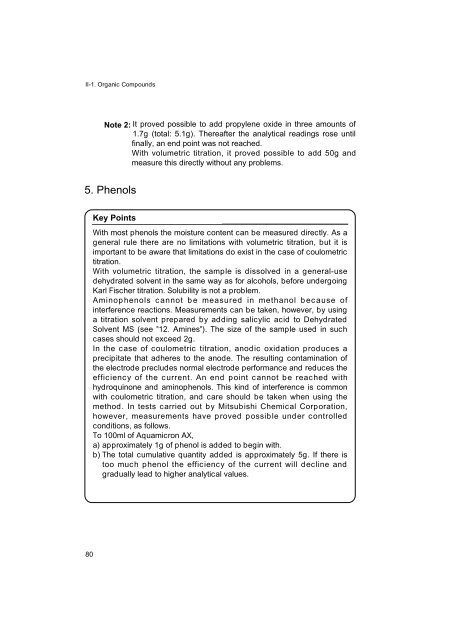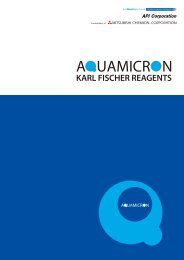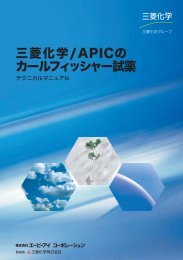Development of Karl Fischer Reagents
Development of Karl Fischer Reagents
Development of Karl Fischer Reagents
You also want an ePaper? Increase the reach of your titles
YUMPU automatically turns print PDFs into web optimized ePapers that Google loves.
II-1. Organic Compounds<br />
80<br />
Note 2: It proved possible to add propylene oxide in three amounts <strong>of</strong><br />
1.7g (total: 5.1g). Thereafter the analytical readings rose until<br />
finally, an end point was not reached.<br />
With volumetric titration, it proved possible to add 50g and<br />
measure this directly without any problems.<br />
5. Phenols<br />
Key Points<br />
With most phenols the moisture content can be measured directly. As a<br />
general rule there are no limitations with volumetric titration, but it is<br />
important to be aware that limitations do exist in the case <strong>of</strong> coulometric<br />
titration.<br />
With volumetric titration, the sample is dissolved in a general-use<br />
dehydrated solvent in the same way as for alcohols, before undergoing<br />
<strong>Karl</strong> <strong>Fischer</strong> titration. Solubility is not a problem.<br />
Aminophenols cannot be measured in methanol because <strong>of</strong><br />
interference reactions. Measurements can be taken, however, by using<br />
a titration solvent prepared by adding salicylic acid to Dehydrated<br />
Solvent MS (see "12. Amines"). The size <strong>of</strong> the sample used in such<br />
cases should not exceed 2g.<br />
In the case <strong>of</strong> coulometric titration, anodic oxidation produces a<br />
precipitate that adheres to the anode. The resulting contamination <strong>of</strong><br />
the electrode precludes normal electrode performance and reduces the<br />
efficiency <strong>of</strong> the current. An end point cannot be reached with<br />
hydroquinone and aminophenols. This kind <strong>of</strong> interference is common<br />
with coulometric titration, and care should be taken when using the<br />
method. In tests carried out by Mitsubishi Chemical Corporation,<br />
however, measurements have proved possible under controlled<br />
conditions, as follows.<br />
To 100ml <strong>of</strong> Aquamicron AX,<br />
a) approximately 1g <strong>of</strong> phenol is added to begin with.<br />
b) The total cumulative quantity added is approximately 5g. If there is<br />
too much phenol the efficiency <strong>of</strong> the current will decline and<br />
gradually lead to higher analytical values.




